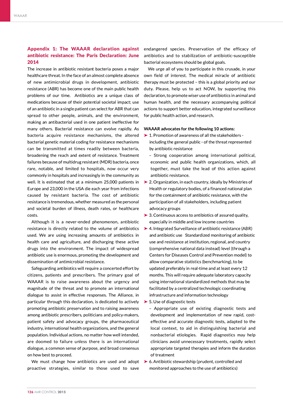
Appendix 1: The WAAAR declaration against
antibiotic resistance: The Paris Declaration: June
2014
The increase in antibiotic resistant bacteria poses a major
healthcare threat. In the face of an almost complete absence
of new antimicrobial drugs in development, antibiotic
resistance (ABR) has become one of the main public health
problems of our time. Antibiotics are a unique class of
medications because of their potential societal impact; use
of an antibiotic in a single patient can select for ABR that can
spread to other people, animals, and the environment,
making an antibacterial used in one patient ineffective for
many others. Bacterial resistance can evolve rapidly. As
bacteria acquire resistance mechanisms, the altered
bacterial genetic material coding for resistance mechanisms
can be transmitted at times readily between bacteria,
broadening the reach and extent of resistance. Treatment
failures because of multidrug resistant (MDR) bacteria, once
rare, notable, and limited to hospitals, now occur very
commonly in hospitals and increasingly in the community as
well. It is estimated that at a minimum 25,000 patients in
Europe and 23,000 in the USA die each year from infections
caused by resistant bacteria. The cost of antibiotic
resistance is tremendous, whether measured as the personal
and societal burden of illness, death rates, or healthcare
costs.
Although it is a never-ended phenomenon, antibiotic
resistance is directly related to the volume of antibiotics
used. We are using increasing amounts of antibiotics in
health care and agriculture, and discharging these active
drugs into the environment. The impact of widespread
antibiotic use is enormous, promoting the development and
dissemination of antimicrobial resistance.
Safeguarding antibiotics will require a concerted effort by
citizens, patients and prescribers. The primary goal of
WAAAR is to raise awareness about the urgency and
magnitude of the threat and to promote an international
dialogue to assist in effective responses. The Alliance, in
particular through this declaration, is dedicated to actively
promoting antibiotic preservation and to raising awareness
among antibiotic prescribers, politicians and policy-makers,
patient safety and advocacy groups, the pharmaceutical
industry, international health organizations, and the general
population. Individual actions, no matter how well intended,
are doomed to failure unless there is an international
dialogue, a common sense of purpose, and broad consensus
on how best to proceed.
We must change how antibiotics are used and adopt
proactive strategies, similar to those used to save
endangered species. Preservation of the efficacy of
antibiotics and to stabilization of antibiotic-susceptible
bacterial ecosystems should be global goals.
We urge all of you to participate in this crusade, in your
own field of interest. The medical miracle of antibiotic
therapy must be protected - this is a global priority and our
duty. Please, help us to act NOW, by supporting this
declaration, to promote wiser use of antibiotics in animal and
human health, and the necessary accompanying political
actions to support better education, integrated surveillance
for public health action, and research.
WAAAR advocates for the following 10 actions:
‰ 1. Promotion of awareness of all the stakeholders including
the general public - of the threat represented
by antibiotic resistance
- Strong cooperation among international political,
economic and public health organizations, which, all
together, must take the lead of this action against
antibiotic resistance.
‰ 2. Organization, in each country, ideally by Ministries of
Health or regulatory bodies, of a financed national plan
for the containment of antibiotic resistance, with the
participation of all stakeholders, including patient
advocacy groups
‰ 3. Continuous access to antibiotics of assured quality,
especially in middle and low income countries
‰ 4. Integrated Surveillance of antibiotic resistance (ABR)
and antibiotic use Standardized monitoring of antibiotic
use and resistance at institution, regional, and country
(comprehensive national data instead) level (through a
Centers for Diseases Control and Prevention model) to
allow comparative statistics (benchmarking), to be
updated preferably in real-time and at least every 12
months. This will require adequate laboratory capacity
using international standardized methods that may be
facilitated by a centralized technologic coordinating
infrastructure and information technology
‰ 5. Use of diagnostic tests
- Appropriate use of existing diagnostic tests and
development and implementation of new rapid, costeffective
and accurate diagnostic tests, adapted to the
local context, to aid in distinguishing bacterial and
nonbacterial etiologies. Rapid diagnostics may help
clinicians avoid unnecessary treatments, rapidly select
appropriate targeted therapies and inform the duration
of treatment
‰ 6. Antibiotic stewardship (prudent, controlled and
monitored approaches to the use of antibiotics)
WAAAR126 AMR CONTROL 2015